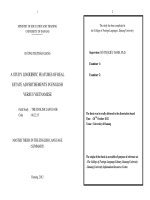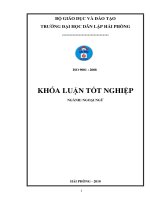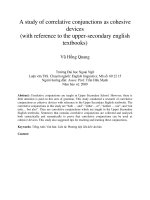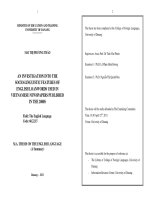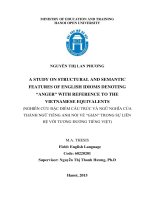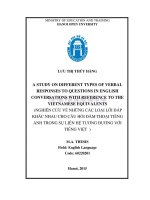- Trang chủ >>
- Thạc sĩ - Cao học >>
- Luật
A study on linguistic features of english printed advertisements in tourism with reference to the vietnamese equivalent
Bạn đang xem bản rút gọn của tài liệu. Xem và tải ngay bản đầy đủ của tài liệu tại đây (13.05 MB, 113 trang )
MINISTRY OF EDUCATION AND TRAINING
HANOI OPEN UNIVERSITY
M.A. THESIS
A STUDY ON LINGUISTIC FEATURES OF ENGLISH
PRINTED ADVERTISEMENTS IN TOURISM WITH
REFERENCE TO THE VIETNAMESE
EQUIVALENTS
(NGHIÊN CỨU CÁC ĐẶC ĐIỂM NGÔN NGỮ CỦA ẤN PHẨM QUẢNG
CÁO TIẾNG ANH TRONG DU LỊCH VỚI CÁC LIÊN HỆ TƯƠNG
ĐƯƠNG TRONG TIẾNG VIỆT)
LÊ THANH TÚ
Hanoi, 2017
MINISTRY OF EDUCATION AND TRAINING
HANOI OPEN UNIVERSITY
M.A. THESIS
A STUDY ON LINGUISTIC FEATURES OF ENGLISH
PRINTED ADVERTISEMENTS IN TOURISM WITH
REFERENCE TO THE VIETNAMESE
EQUIVALENTS
(NGHIÊN CỨU CÁC ĐẶC ĐIỂM NGÔN NGỮ CỦA ẤN PHẨM QUẢNG CÁO
TIẾNG ANH TRONG DU LỊCH VỚI TƯƠNG ĐƯƠNG TRONG TIẾNG VIỆT)
LÊ THANH TÚ
Field: English Language
Code: 60220201
Supervisor: Tran Thi Thu Hien, Ph.D
Hanoi, 2017
CERTIFICATE OF ORGINALITY
This work contains no material which has been accepted for the award of any
other degree in any university or other tertiary institution. Furthermore, it contains
no material previously published or written by other people, except where due to the
references has been made in the text.
Hanoi, 2017
Le Thanh Tu
Approved by
SUPERVISOR
Tran Thi Thu Hien
Date:
i
ACKNOWLEDGEMENTS
First and foremost, I would like to express my sincere gratitude to my
supervisor, Tran Thi Thu Hien, Ph.D for her deliberate guidance and invaluable
feedback and suggestion during the writing of this research. Without her
supervising I would never have started, and certainly never have finished writing
my thesis.
My sincere thanks go to all lecturers and the staff of the Department of Post
Graduate Studies at Hanoi Open University for their useful materials, guidance and
enthusiasm during my study at the institution.
Last but not least, I am also indebted to my beloved family members whose
continuous support and concern have always been the motivation for me to
complete my study.
ii
ABSTRACT
This thesis is focused on analyzing some typical lexicology, morphological
and syntactic features in English printed advertisements in tourism, as well as
finding out the similarities and differences in syntactic, lexical and morphological
features between English and Vietnamese advertisements in tourism. To analyze
these features, 40 advertisements of both language have been collected as the data
for this thesis under the form of brochures, leaflets and itineraries of the notable and
prestigious travel agents domestically and internationally, of which 20
advertisements have been chosen to sudy in the thesis. Basing on the findings, the
thesis provides some suggestions for advertisers, translators and the learners of
English as the second language in advertising and translating. This will help
Vietnamese writers answer the question if we should translate a Vietnamese tourism
advertisement into English to have a perfect equivalent.
iii
LIST OF ABBREVIATION
Ad:
Advertisement
Adj:
Adjective
Ads:
Advertisements
N:
Noun
Tads:
Tourism advertisements
V:
Verb
iv
LIST OF TABLES
Table 2.1: Common compounding patterns (adapted from Carstairs-McCarthy
(2002:60)) ..................................................................................................................20
Table 4.1: Frequency of types of sentences in chosen English advertisements........32
Table 4.2: Frequency of sentences including “can”, “will” English printed tourism
advertisements ...........................................................................................................35
Table 4.3: Occurrence of the favorable adjectives in English printed tourism ads ..37
Table 4.4: Occurrence of word types in English printed ads in tourism...................39
Table 4.5: Formation of compound words in English printed ads in tourism .........41
Table 4.6: Suffixes –s/-es/-ed of verbs in English printed tourism advertisements..42
Table 4.7: Summary of the derivational suffixes in English printed tourism
advertisements ...........................................................................................................44
Table 4.8: Summary of the derivational suffixes of adjectives in English printed
tourism advertisements..............................................................................................46
Table 4.9: Occurrence of sentence types in Vietnamese printed advertisements in
tourism.......................................................................................................................49
Table 4.10: Occurrence of used verbs in Vietnamese printed tourism ads ...............53
Table 4.11: Occurrence of word types in Vietnamese printed tourism ads ..............55
v
TABLE OF CONTENTS
CERTIFICATE OF ORGINALITY .................................................................... i
ACKNOWLEDGEMENTS .................................................................................. ii
ABSTRACT ............................................................................................................ iii
LIST OF ABBREVIATION ................................................................................ iv
TABLE OF CONTENTS ..................................................................................... vi
Chapter 1. Introduction ......................................................................................... 1
1.1. Rationale for the study.................................................................................... 1
1.2. Aims of the study ............................................................................................ 2
1.3. Objectives of the study ................................................................................... 2
1.4. Scope of the study ........................................................................................... 3
1.5. Significance of the study ................................................................................ 3
1.6. Structural organization of the study ............................................................... 3
Chapter 2. Literature review ................................................................................ 5
2.1. Review of previous studies ............................................................................... 5
2.2. Overview of syntax............................................................................................ 8
2.2.1. Types of sentence ............................................................................................ 9
2.2.2. Voice, Tense, and Mood ............................................................................... 10
2.3. Overview of Lexicology ................................................................................... 12
2.3.1. Verbs .............................................................................................................. 12
2.3.2. Adjectives, comparative and superlative degrees....................................... 13
2.3.3. The use of nouns and advebs ...................................................................... 15
2.3.4. Compounding................................................................................................ 16
2.4. Overview of Morphology................................................................................ 17
2.4.1. Inflection........................................................................................................ 19
2.4.2. Derivation...................................................................................................... 19
2.4.3. Compounding ................................................................................................ 20
2.5. Advertising and advertisements ...................................................................... 21
2.5.1. Advertising .................................................................................................... 21
vi
2.5.2. Advertisements .............................................................................................. 24
2.3. Chapter summary ............................................................................................. 25
Chapter 3. Methodology ...................................................................................... 26
3.1. Study- governing orientations ......................................................................... 26
3.1.1. Research questions ....................................................................................... 26
3.1.2. Research setting ............................................................................................ 26
3.1.3. Research approach ....................................................................................... 27
3.1.4. Principles/criteria for data collection and data analysis........................... 27
3.2. Study method ................................................................................................... 28
3.2.1. Major methods vs. supporting methods....................................................... 28
3.2.2. Data collection techniques ........................................................................... 28
3.2.3. Data analysis techniques .............................................................................. 29
3.3. Chapter summary .......................................................................................... 30
Chapter 4. Linguistic features of English printed advertisements in tourism
with reference to the Vietnamese equivalents .................................................. 31
4.1. Syntactic features ............................................................................................. 31
4.1.1. Types of sentence .......................................................................................... 31
4.1.2. Voice, Tense, Mood ...................................................................................... 33
4.2. Lexical features ................................................................................................ 35
4.2.1. Verbs ............................................................................................................. 35
4.2.2. Adjectives, comparative and superlative degrees....................................... 37
4.2.3. Nouns and adverbs ....................................................................................... 39
4.2.4. Compounding................................................................................................ 40
4.3. Morphological features.................................................................................... 42
4.3.1. Inflection........................................................................................................ 42
4.3.2. Derivation ..................................................................................................... 44
4.3.3. Compounding................................................................................................ 47
4.4. Comparison between English and Vietnamese printed tourism
advertisements in terms of lexical, morphological and syntactic features .......... 48
vii
4.4.1. In terms of syntax .......................................................................................... 48
4.4.1.1. Types of sentence ....................................................................................... 48
4.4.1.2. Voice, Tense and Mood ............................................................................. 50
4.4.2. In terms of Lexicology .................................................................................. 53
4.4.2.1. Verbs........................................................................................................... 53
4.4.2.3. Nouns and adverbs .................................................................................... 54
4.4.2.4. Compounding .............................................................................................. 56
4.2.3. In terms of Morphology................................................................................ 56
4.5. Implications ...................................................................................................... 58
4.5.1. Implications for creating effective advertisements ..................................... 58
4.5.2. Implications for translating ......................................................................... 58
4.5.3. Implications for teaching ............................................................................. 59
4.6. Chapter summary ............................................................................................. 60
Chapter 5. Conclusions ........................................................................................ 61
5.1. Recapitulation .................................................................................................. 61
5.2. Concluding remarks......................................................................................... 62
5.3. Limitations of the study................................................................................... 63
5.5. Suggestions for further studies........................................................................ 63
REFERENCES ..................................................................................................... 64
APPENDIX ............................................................................................................ 67
viii
Chapter 1
INTRODUCTION
1.1.
Rationale for the study
Along with the rapid development of social economy, advertising is
becoming increasingly popular. In order to secure a number of readers and to
compete with many other similar advertising messages, advertisers try to make their
advertisements as effective as possible. They use various linguistic devices to catch
attention, arouse desire, induce action, and contribute towards satisfaction.
Furthermore, advertising has been considered as a real art – the art of informing,
persuading customer and deeply embedded into their minds. According to Berger
(2004:71), advertising is described as “a genre of communication that use words
and images to convince people exposed to the advertisements to purchase product
or service being promoted”. The explanation is also appropriate for the case of
tourism advertisements, as tourism advertisements try to charm the reader and
determine him to purchase the service.
Nowadays, tourism is presently one of the fastest growing economic sectors
in the world. According to United Nation World Tourism Organization,
international tourist arrivals grew by 5% in 2013 to 1.087 billion and a grow by 6%
in 2017 is forecast. As tourism has established as one of the most prolific business
worldwide, tourism advertisements find itself as being one of the most widespread
public means of communication. The language of tourism is meant to create a
special world, appealing and marvelous. It provides the potential customers with a
preconceived impressive image of respective place. Thus, the tourist sees and
experiences what he was told to expect in the tourist description. Hence, the
importance of tourism language: it builds up fairy tale realms, magical places, oasis
of peace and tranquility, auras of mystery and fantasy.
Various form are used in advertisements, and advertisers pay much attention
to expressive devices as plates, colors or layout of printed pages, however, language
is the main carrier of message all long. Language has become a very efficient
1
element in connection with other aids to appeal the consumption of the readers. In
the practice of the advertising, advertisers normally pay more attention to the use of
words or types of sentences to make the advertisements more vivid, persuasive and
reliable, and then to stimulate the desire to buy and advertised products.
In this thesis, the study generalizes the major linguistic features of
advertisements in tourism in the hope of helping language learners to understand
English advertisements and to appreciate at the beauty of advertising language. To
do so, the writer restricts discussion to the language of the commercial
advertisements in printed documents (also called printed advertisements) and then
find out some similarities and differences between English and Vietnamese
languages used tourism advertisements. However, this study does not desire to
describe all the language characteristics of tourism advertisements in English and
Vietnamese, focusing only on syntactic, lexical and morphological features which
are considered as the most typical features in advertising language.
1.2.
Aims of the study
This thesis aims at investigating the syntactic, lexical and morphological
features in the English and Vietnamese printed advertisements in tourism as well as
discover the similarities and differences of these features between the two
languages.
1.3.
Objectives of the study
There are three primary objectives of this study:
(i)
To find out the typical features of syntax, lexical and morphology in
English printed advertisements in tourism.
(ii)
To identify the similarities and differences of syntactic, lexical and
morphological features between English and Vietnamese printed
advertisements in tourism.
(iii)
To draw out some possible implications for advertiser, translators,
teachers of English as the second language from syntactic, lexical and
morphological features of tourism advertisements.
2
1.4.
Scope of the study
This thesis does not cover all aspects of the advertising language as
well as all language features of printed tourism advertisements due to the
time limitation and with the limited scope of MA thesis. This thesis refers to
some features of English printed tourism advertisements based on syntax,
lexicology and morphology.
For analyzing syntactic, lexical and morphological features of
advertising language in this thesis, pieces of tourism advertisements are not
selected from all kinds of media but from some brochures, leaflets and
itineraries of the notable travel companies and enterprises in Vietnam and of
some prestigious promotion agencies from other countries such as England,
Australia, America, etc. having representative offices in Vietnam. The thesis
concentrates on the
description, analysis and comparison
of
20
advertisements in both languages, English and Vietnamese.
1.5.
Significance of the study
The significance of the thesis can be discussed from two major perspectives:
-
The information in the thesis may help advertisers, translators and
teachers of English as the second language gain an insight into printed
tourism advertisements in English from the perspective of the syntax,
lexicology and morphology.
-
The study, to some extent, can give some guidelines for advertisers,
translators and Vietnamese teachers of English as a foreign language
about printed tourism advertisements from the perspective of the syntax,
lexicology and morphology.
1.6.
Structural organization of the study
The study consists of five main chapters as follows:
Chapter 1 – Introduction: Gives brief information about the study such as
rationale, aims and objectives, scope, significance and structure of the study.
3
Chapter 2 – Literature: Deals with theoretical background on syntax,
lexicology, morphology, advertising and advertisements.
Chapter 3 - Methodology: Defines and presents the methodology of the
study. Determination of the samples will also be explained. Methods examined will
be those for collection and analysis of the data utilized throughout the study.
Chapter 4 – Linguistic features of English printed advertisements in tourism
with reference of the Vietnamese equivalents: Presents some syntactic, lexical, and
morphological features of printed tourism advertisements in English and draws out
some similarities and differences in syntactic, lexical, and morphological features
between English and Vietnamese printed ads in tourism advertisements, then
indicates some implications for advertisers, translators, teachers of English as the
second language.
Chapter 5: Conclusions - Summaries the major findings resulted from the
investigation. Furthermore, presents some limitations of the study, and suggestions
for further studies.
4
Chapter 2
LITERATURE REVIEW
2.1. Review of previous studies
The study of language of advertising from a linguistic perspective has been
attempted by several scholars (Leech 1966; Geis 1982; Vestergaard and Schrodder
1985; Mencher 1990, etc.). Leech (1966), in his pioneering and comprehensive
study on English in advertising, has analyzed in detail different aspects pertaining to
grammar, vocabulary, discourse and rhyme and rhetoric of advertising with special
reference to television. He has effectively related these aspects with the functional
factors such as attention value, listenability/readability, memorability and selling
power. Illustration, display typography, vocal emphasis, prompt spelling,
grammatical solecism, metaphor and paradox are some of the aspects linked with
attention value. Simple and colloquial style and familiar vocabulary are connected
with readability. Phonological regularities such as alliteration, rhythm, rhyme and
jingle are related to memorability. Frequent use of imperatives and superlatives are
connected with selling power. The distinctive property of advertising language has
been closely identified with the use of clauses, phrases and words as minor
sentences, which constitute a different kind of grammar called as disjunctive
grammar.
Geis (1982) has made an attempt to describe how language is used in
American advertising, especially television advertising. He has focused on certain
linguistic devices that figure most prominently in advertising. According to him, the
advertising claims employing the word ‘help’ as in phrases like ‘helps to achieve’
and comparative phrases like ‘more or less’ are impressive because they are
indistinguishable from the law like generic claims of scientists. He has concluded
that advertisers in general tend to prefer vague language rather than language with
explicit empirical consequences and to prefer subjective claims to objective claims.
Vestergaard and Schroder (1985) have studied the language use in
commercial press advertising in relationship with communicative functions of
5
language such as expressive, directive, informational, contextual and poetic etc.
They have also identified the importance of imperatives and directive speech acts in
encouraging the audience to buy the products.
Mencher (1990) has looked into the aspect of vocabulary in advertising and
identified ten words as the most personal and persuasive. They are: “new”, “save”,
“safety”, “proven”, “love”, “discover”, “guarantee”, “results”, “you” and
“health”. The psychological impact of these words on the consumers has also been
discussed.
Advertising language has also been studied by other scholars. Toolan (1988)
provides a list of standard features of English advertisements. Similar to Leech
(1966), Toolan is interested in recurrent syntactic, grammatical and lexical patterns
and only briefly comments on the ideological and ethical sides of advertising, such
as its ability to “direct us towards acquisition and pleasure of unessential material
goods” (Toolan, 1988:63). Dyer (1982) examines advertising as a kind of
communication in modern societies, which involves both cultural and economic
context for discussion. Cook (1992) investigates advertisements as a discourse type.
In other words, advertising is viewed as a major discourse type in many societies.
This author offers a comprehensive introduction to advertising discourse by
examining the language of complementary advertisements. In his research, fourteen
prototypical significant features of advertisements are also supplied (Cook,
1992:214). Similarly, Goddard (1998) in her book called “The language of
advertising” also studies the discourse of advertising, focusing on the interaction
between textual (e.g., connotation) and contextual elements (e.g. the music or the
pictures or the narrative voice of the speaker)
Besides, Fries (1993) does a research on advertising language in terms of
information prominence. In his study, advertisements are examined in terms of
Theme-Rheme structure. A new term is created “N- Rheme” (for New Rheme)
which refer to the last element of clause complexes. In this study, N- Rhematic
information and Thematic information are presented and compared to see where
6
information which is directly related to the persuasive goals of the advertisements
(e.g., product name, product features, product functions and product estimations) is
placed in clause structure. The study shows that those persuasive objectives of
advertising are placed at the N- Rheme position. All of those studies explore
advertising language as it is embedded in the context of situation.
The approach chosen by Myers (1994) is rather close to that adopted by
Cook (1992). In addition to identifying the significant features of advertisements,
his aim is to investigate language in the society in which it is produced and to
analyze how context influences the interpretation of advertisements. In general, one
cannot investigate advertisements without considering the relation between the
language and the situation (Leech, 1966:4).
In addition, Schaffner (2001: 2013) and Goddard (1998:30-31) distinguish a
number of linguistic features typical of the English advertising language: imitation
of spoken language, short, elliptical sentences, positive evaluative expressions and
abundance of stylistic means affecting the audience (proverb, puns, alliteration,
rhyme, etc.). The listed features of language are culture-specific in their use and
intensify within the same register (Steiner,, 2004:21).
In Vietnam, there are not many comprehensive woks on the same field
except for some books concerning advertising techniques as well as some BA
papers and MA theses of students specializing in Marketing Studies of Linguistics.
Tran (2007) focuses on the contrast between English and Vietnamese
advertisements with respect to different types of presupposition and implicature in
the light of pragmatics in his M.A thesis. Maksimainen (2011) carries out a M.A
thesis on slogans in refractive surgery advertising using a descriptive analytic
approach. In the thesis, the author only pays attention to the investigation of
syntactic, structural and grammatical features as well as some minor lexical
characteristics of those slogan.
Concerning studies of advertisements in tourism, there has been a noticeable
PhD dissertation carried out on advertising language - “A discourse analysis of
7
Travel advertisements in English and Vietnamese”- which was done by Ton Nu My
Nhat in 2005. This is a contrastive analysis of travel advertisements based on the
theory of Functional Grammar. Similarly, Ho (2011) carries out a M.A thesis on
contrasting analysis of travel advertisements in terms of the layout, lexical features,
cohesive and stylistic devices.
All the above-mentionted researchs have partly satisfied the desires of the
people who are interested in the advertising fields. However, some of them have not
mention all the typical linguistic features in the field of tourism advertising.
Besides, others have not have profound insights in terms of syntactic, lexicological
and morphological features in printed tourism advertisements as it has been done in
my study as well. As a result, the author do hope that this thesis will provive a full
and significant approach in terms of syntax, lexicology and morphology in printed
tourism advertisements.
2.2. Overview of syntax
Traditionally, grammar is divided into morphology and syntax. Morphology
is the grammar of words and the form of word, whereas syntax is the grammar of
sentences and is connected with the way that sentences are built. Miller (2000)
defines: “syntax has to do with how words are put together to build phrases, with
how phrases are put together to build clauses or bigger phrases, and with how
clauses are put together to build sentences”. In other words, syntax is the study of
the relationship between linguistic forms, how they are arranged in sequence, and
which sequences are well-formed.
Words in English fall into a number of word classes- nouns, verbs, adjectives
and so on. Word classes were traditionally defined by what they denoted – people,
places, and things (nouns), actions (verbs) and properties (adjectives). Words are
grouped into phrases, which consist of a word called a head and other words
(modifiers) which are said to modify the head. In the big ball, the word ball is the
head and the and big are its modifiers.
8
According to Miller (2005:5), another unit of syntax is the clause which
enables us to talk coherently about the relationship between verbs and different
types of phrase. An ideal clause includes a phrase referring to an action or state, a
phrase or phrases referring to the people and things involved in the action or state,
and possibly phrases referring time and place. For example, in clause My brother
sold a car, the phrase my brother refers to the seller, sold refers to the action and a
car refers to what was sold.
2.2.1. Types of sentence
Words are the smallest units of syntax; however, sentences are the largest
ones. A sentence is the basic unit of language that expresses a complete thought by
following the grammatical rules of syntax. A real sentence has at least (a minimum
of) a subject and a main verb to state (declare) a compete thought. In English, a
simple sentence (containing a single, independent clause) with a verb (an action),
subject (who or what is doing the action), and an object (who or what the action is
done to) is written is a Subject-Verb-Object word order. For example, in the
sentence “Sarah has a pen”, Sarah is the subject, has is the verb and a pen is the
object.
Miller, J (2000:62) states that simple sentences in English consist of a single
main clause, but many consist of several clauses. Depending on what types of
clause are combined, two types of multi-clause sentence are distinguishes.
Compound sentences contain two or more independent clauses joined by a
coordinating conjunction. The most common coordinating conjunction are: and, or,
but, so. For example:
I love John but John loves Sarah.
The next type of multi-clause sentence is complex sentence which contains one
main clause (independent clause) and one or more other subordinate it (dependent
clauses). That is, one clause, the main clause is preeminent in a complex sentence
and the other clauses, the subordinate clauses, are subject to certain limitation.
There are some types of
subordinate clauses: noun clause (modifying verbs),
9
adjective clause (modifying nouns) and adverbial clause (modifying whole main
clauses). For example:
I did not know what had happened to her. (noun clause)
The villa that we had visited was destroyed last year. (adjective clause)
When I went home, I realized that there was no one at home. (adverbial
clause)
Talbut Onions, Charles et al (1971:2) also gives another types of sentences,
that is elliptical sentence or ellipsis. Elliptical sentences lack one or some parts that
are ideally necessary to full form of a sentence as defined above. Elliptical
sentences play an important role in English as well as in other languages. They are
common in all styles of speaking and writing ,they give precision and brevity, save
time and troubles. For example, in the sentence, The garden to be sold, the verb
“be” is omitted. Ellipsis is most commonly used to avoid repetition. Another
important reason for ellipsis is that by omitting share items attention is focused on
new material. For example:
A: Have you seen Charles?
B: Not yet (I have not seen him yet)
2.2.2. Voice, Tense, and Mood
Voice relates to situation, not to time but to which participants in a situation are
presented to the hearer/reader and which participants are presented as central. There
are two kinds of voice: active and passive. Miller, J (2000:151) offers us two
example of voice:
(a) Emma and Harriet were attacked yesterday (by those ruffians).
(b) Those ruffians attacked Emma and Harriet yesterday.
Example (a) is an one of the passive voice clause which mentions mainly the patient
and possibly omits the agent of action. The active voice order agent-action-theme
seems to be the most common order for English speakers. Passive voice verbs begin
with the copular verb be, which is followed by the main verb in its past participle
form (e.g., eaten, attacked, sung). In passive voice, it is not necessary to specify the
10
agent. The by prepositional phrase containing the agent can be omitted, as the
parentheses around it indicate. After copular verb be and main verb, passive voice
clauses can be followed by by prepositional phrase or an embedded sentence as the
following examples:
She was surprised that her husband was killing the dog fiercely.
While voice relates to situation, mainly to the participants in situation, tense
is the grammatical marking on verb that usually indicates time reference relative to
either the time of speaking or the time at which some other situation was in force.
Similarly, according to Miller, Jim (2000:148) there are two types of tense: present
and past tense. In fact, future tense is controversial because it is achieved by verbs
will or go combined with other verbs while speakers refer to present and past time
by means of a single verbs. Present and past tense both formed from verbs stems
plus suffixes –s and –ed.
Mood of a verb or verb phrase indicates your attitude toward a statement as
you make it. As Quirk, R et al (1973:40) stated, mood “relates the verbal action to
such condition as certainty, obligation, necessity, possibility”. In classification of
Miller, Jim (2000), there are there types of mood in English: indicative, imperative
and subjunctive. The indicative mood is for statement of actuality or strong
probability, for example, a mouse lies on the floor. Most sentences in English are
the indicative mood. It states a fact of some sort, or describes what happens, or
gives details about reality. The imperative mood is for commands and requests
made directly: “give me a hand”. One marker of the imperative is that frequently the
subject does not appear in the sentence, but is only implied “(someone) give me a
hand.” Another, rare mood is the subjunctive mood which indicate a hypothetical
state, a state contrary to reality, such as a wish, a desire, or an imaginary situation. It
is most often found in a clause beginning with the if. It is also found in clause
following a verb that express a doubt, a wish, regret, request, demand, or proposal.
The subjunctive mood can be expressed by using one of the modal auxiliaries which
11
contain could, can, may, might, will, etc. For example, he could/may/might be in the
house.
In fact, voice, tense, and mood are not only parts of English syntax, but also
belong to the morphological features of verbs. Therefore, voice, tense and mood, in
this thesis, are taken into consideration in the light of morpho-syntax. Morphosyntax is the study of grammatical categories or linguistic units that have both
morphological and syntactic properties. Voice, tense and mood of verbs have
features of inflection morphology, that is with or without inflectional suffix –s/-es/ed, and they also show how verbs and other word classes are put together to build
clauses
2.3. Overview of Lexicology
As a mean to convey information and make people see and remember it
easily. Advertising should be compact, vivid, visual, emotional and attractive. To
realize this aim, the choice of words play a vital role. The lexical features of
advertising language vary great deal, sometimes serious but typically all of them
aim to help products or services stand out, disarm or distract the consumer and
memory. Therefore, in term of lexical features, words or phrases of positive
meaning are widely employed to stress the best sides of product or service. This
part of work will be concerned with typical characteristics of the vocabulary in
advertising language including the usage of verbs, adjectives with comparative and
superlative degrees, nouns, adverds, pronouns and possessive determiners, the
compounding
2.3.1. Verbs
English ad requires the predicative verbs simple and clear-cut to make its
language brief and easily understood. The result of the research on advertising
effect show the frequently used verbs in English ads which include bring, choose,
enjoy, feel, get, give, have, keep, like, love, make, need, save, serve, take, try, use,
watch, etc. For example:
Give your special gift to your good friend
12
Making life a little sweeter
All the verbs above-listed are monosyllabic and most of them have AngloSaxon origin that is the common core of English vocabulary. Linguistic study
shows English native speakers tend to use words of Anglo-Saxon origin, because
native words have comparably stable meaning. In advertising, these simple words
can help win consumers by their exact, effective expression and a kind of closeness.
In a research on advertising language, Leech (1966:20) presents a list of the
most common lexical verbs, among which the twenty most popular are listed as
followed
1. Make
11. Look
2. Get
12. Need
3. Give
13. Love
4. Have
14. Use
5. See
15. Feel
6. Buy
16. Like
7. Come
17. Choose
8. Go
18. Take
9. Know
19. Start
10. Keep
20.Taste
When Leech’s list of verbs is compared with the twelve most lexical verbs
collected by Biber et al. (2002:110), there appear many similarities. The verbs
make, get, give, see, come, go and know are on both list, for instance.
a, We will also go to the Ferrari World for a photo shoot only.
b, You can see straw work and handloom weaving in the main building,
coarse oilpaper umbrella making and tub making in the mud-walled warehouse,
and paper millimg, bamboo work and forgiving in other working hut.
2.3.2. Adjectives, comparative and superlative degrees
Advertising language has to be vivid and appealing, so a large number of adjectives
are employed in it, for they are of a word class which is more productive and abundant in
13
number. In advertisements, adjectives render the language more colorful and enhance the
attractiveness of the advertised product. Therefore, adjectives are called the “blood” in
building up an advertisement text.
Adjectives in the advertisements often act as “the wrapping ideal goal of
what is intended to be sold or provided” (Goddard, 1998:205). Jefkins (1994:202)
also states that “if advertising experts were asked to use only on words, they will
probably use an adjective”. In general, adjectives are essential in ads because they
are used to “add prestige and desirability and approval for the consumer” (Dyer,
1982:149). Leech (1966), who declares that in ad the adjective vocabulary is much
richer and more common than the verb vocabulary, provides a list of the twenty
most common adjectives presented below:
1. New
11. Crisp
2. Good/better/best
12. Fine
3. Free
13. Big
4. Fresh
14. Great
5. Delicious
15. Real
6. Full
16. Easy
7. Sure
17. Bright
8. Clean
18. Extra
9. Wonderful
19. Safe
10. Special
20. Rich
Among those words, “new” is the most common one, which shows people’s
desire for original ideas and fresh concepts. For example:
Our newest classic
A new era in the world of cruising
While reading ads, the hyperbolic character of the language may be noticed.
This exaggeration leads to the increased number of comparative and superlative
adjectives. In general, adjectives can appear in basic, comparative and superlative
forms in advertising language.
14
In addition to favorable adjectives, advertisers tend to use comparative and
superlative degrees to indicate the excellent quality of product or service. However,
it is illegal for advertisers to unfairly attacked other product or ads, the advertiser do
not make specific comparison between their products and others by referring to
their rivals. In advertising texts, such comparatives are frequently used to show the
product distinctive qualities. For instance:
With extra room for you in your new Swiss Business Class designed to relax
you even more.
Furthermore, advertisers also use the superlative degree to describe the
uniqueness of the product. For example:
And when wed to over 50 EF autofocus lenses, the newest entry into the EOS
system pops the ultimate question.
By using the superlative degree, the ad convey the message that the product
advertised is equipped with the lasts technology, hence the best of its kind without
speaking ill of others.
2.3.3. The use of nouns and advebs
In English advertisement, nouns include the proper name, names of product
and service and the descriptive words of products. Supposing adjectives in
advertisement texts tell you “How is this?” nouns then give the answers to “What is
this?” and “Why is this?” In advertising, noun is called the “muscle” of the body
text. But there are too many nouns in English vocabulary, so it is an art how to
make the selected ones function to the largest extent in a limited space of an
advertisement. The way of simply overlapping nouns will encounter long faces of
consumers. They will become indifferent towards the advertisement which contains
excessive nouns. As a result, the advertisement itself fails. On the other hand, if
copywriters are able to reasonably limit the number of nouns used in their works
while at the same time make the used nouns play their best roles, the advertisement
may become more attractive and persuasive, and, eventually, consumers may act as
15


